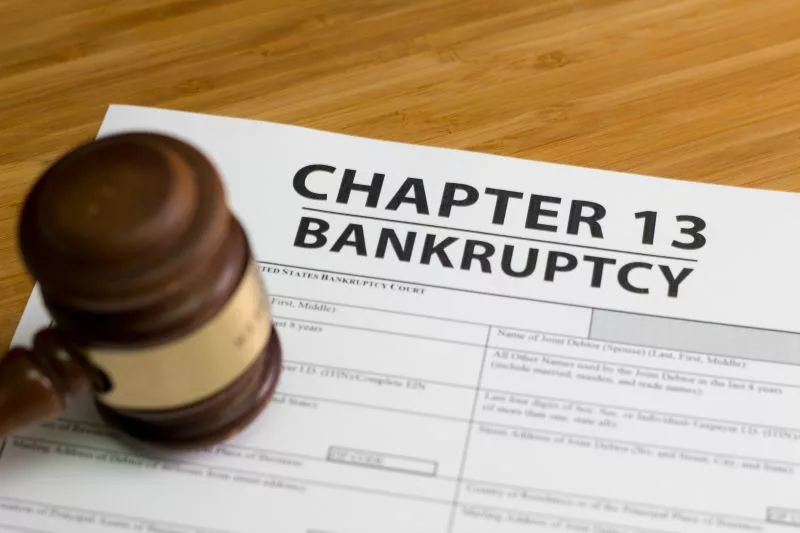Many individuals across America find themselves in a financial predicament. With rising global inflation rates, Americans are looking for viable solutions to regain control of their finances. One of the most effective solutions available is the Chapter 13 bankruptcy process, which allows American taxpayers to devise a plan to repay creditors most or all of their debts.
This article explores the key aspects of Chapter 13 Bankruptcy, including how it impacts your credit history, its advantages, the eligibility requirements, the documentation needed, and how to file for it.

- What Is Chapter 13 Bankruptcy?
- How Does Chapter 13 Bankruptcy Work?
- How Is Chapter 13 Bankruptcy Different from Chapter 7?
- What Happens to Your Debt When You File Chapter 13 Bankruptcy?
- Advantages of Chapter 13 Bankruptcy
- How It Impacts Your Credit Score
- Who Is Eligible?
- How To Apply
- Documentation Needed
- What Happens Next?
- How Much Is the Application Fee?
- How Long Do You Have to Wait?
- From Debt to Freedom
What Is Chapter 13 Bankruptcy?
Chapter 13 bankruptcy, sometimes called reorganization bankruptcy or wage earner’s plan, is a legal process designed to assist individuals and entities to repay their debts to creditors while keeping their assets. This framework is under the United States Bankruptcy Code, which provides individuals with a structured approach to repay their debts. It is one of the cheapest ways to file bankruptcies.
According to the IRS, you can only file for this bankruptcy if you’re a wage earner, self-employed, or a sole proprietor.
How Does Chapter 13 Bankruptcy Work?
If you’re struggling financially while owing debts, you can file for Chapter 13 bankruptcy. But first, you need to ascertain your eligibility to determine if this is your best option.
With the aid of an attorney, you will develop a repayment plan that will show how you plan to repay your debts over the next 3 to 5 years.
How Is Chapter 13 Bankruptcy Different from Chapter 7?
Chapters 13 and 7 are different chapters within the United States bankruptcy code, with different purposes, eligibility criteria, and outcomes.
For instance, Chapter 13, known as “reorganization bankruptcy,” focuses on creating a structured repayment plan over three to five years. Debtors do not have to sell their assets but must use their disposable income to make monthly payments to creditors.
Chapter 7, conversely, involves the sale of non-exempt assets to repay creditors. Most unsecured debts are typically discharged (wiped out) at the end of the process. Chapter 7 is typically faster and offers a relatively quick debt relief option.
Another difference is that while Chapter 7 is for unsecured debts like credit cards, medical bills, and personal loans, Chapter 13 involves a mix of secured and unsecured debts.
While Chapter 7 can be completed within months, Chapter 13 involves a long-term commitment, usually 3 to 5 years. Then again, Chapter 13 can allow you to build your credit score gradually compared to Chapter 7, which might negatively impact your credit score.
| Chapter 13 | Chapter 7 |
| • No need to sell your assets | • Involves sale of non-exempt assets |
| • Long-term commitment (repayment plans take between three and five years) | • Short-term commitment and quick debt relief |
| • Mix of secured and unsecured debts. | • Targets unsecured debts |
| • Allows you to build your credit score | • Might impact your credit score negatively |
What Happens to Your Debt When You File Chapter 13 Bankruptcy?
When you file for Chapter 13 Bankruptcy, a structured process is implemented to address your debts. Secured debts such as mortgage and car loans are included in the repayment plan. You will keep making regular repayments on these debts to keep your assets. Priority debts such as child support and alimony must be paid in full throughout this period.
The regular payments will be made to a court-appointment trustee who then distributes your payments to your creditors according to the repayment plan. These payments are usually based on your free income left after spending on living expenses.
Upon successful completion of your repayment plan, any remaining eligible unsecured debts are discharged. This means you are no longer legally obligated to repay them.
Advantages of Chapter 13 Bankruptcy
Chapter 13 closing process offers a host of benefits for individuals. They include:
- Asset Protection. Chapter 13 allows debtors to retain their valuable assets, such as their home and car, as long as they make the required payments under the repayment plan.
- Prevent foreclosure. Chapter 13 halts foreclosure proceedings through the automatic stay. This allows homeowners to catch up on missed mortgage payments over time while keeping their home.
- Repayment flexibility. Chapter 13 offers a flexible repayment plan based on your income and expenses. This can make it easier to manage your debts, especially if your financial situation improves during the repayment period.
- Protection from creditors. The automatic stay in Chapter 13 stops all collection actions, including wage garnishments, lawsuits, and creditor harassment.
- Unsecured debt discharge. While not all debts are discharged immediately in Chapter 13, some unsecured debts may be discharged at the end of the repayment plan.
It’s important to note that Chapter 13 bankruptcy requires commitment and diligence, as you must make regular payments to the bankruptcy trustee for several years.
How It Impacts Your Credit Score
Filing for Chapter 13 bankruptcy can have a significant impact on your credit score, and this impact can last for several years. Initially, after filing for Chapter 13 bankruptcy, your credit score will experience a drop. This is due to the negative information reported to the credit bureaus (Experian, Trans Union, and Equifax).
This bankruptcy information will remain on your credit report for up to 7 years from the initial date of filing. This could make it difficult to receive favorable loans from other creditors.
Making timely and consistent payments to the trustee as part of your repayment plan can positively impact your credit score. And as you progress through your repayment, you will see improvements in your credit score.
Who Is Eligible?
You are eligible for this bankruptcy if you meet the following requirements:
- You’ve maxed out your credit cards and can’t afford to pay for basic items
- You have a combined secured and unsecured debts of less than $2,750,000 as of the date of filing
- You have sufficient income to cover your necessary living expenses and make the monthly payments
- You have an intention to repay your debts to the best of your ability under the proposed plan
- You must have filed your federal income tax returns for the previous four years before filing
Bankruptcy laws and regulations can change, and an attorney can provide the most up-to-date information.
How To Apply
An attorney of your choosing will estimate how you’ll have to pay, draft, and submit a proposal with relevant documentation to the bankruptcy court. However, before filing for bankruptcy, you must complete a credit counseling course from an approved agency. This course aims to evaluate your financial situation and explore alternatives to bankruptcy.
Documentation Needed
You will provide the following documents when filing for Chapter 13 Bankruptcy:
- Pay stubs or proof of income for the past six months
- Additional sources of income, such as child support, rental income, and alimony if applicable
- Copies of your federal income tax for the past 6 months
- Copies of your bank statements for the past 6 months
- A detail of all your assets, including real estate, vehicles, valuable personal property, investments, and retirement accounts
- A comprehensive list of all your debts, including credit card balances, medical bills, loans, mortgages, car loans, and any other financial obligations
- Proof of completion of the required credit counseling course
Your chosen attorney will help you gather the necessary documentation, complete the required forms accurately, and ensure that your bankruptcy filing complies with all legal requirements.
What Happens Next?
Once your petition is filed, an automatic stay goes into effect, which stops all collection actions by creditors, including foreclosure, repossession, and wage garnishment. Between 20 to 50 days after filing, you will attend a meeting of creditors, also known as a 341 meeting.
Here, the bankruptcy trustee, your attorney, and creditors (if they choose to attend) will ask you questions about your financial situation and proposed repayment plan. After the meeting, a confirmation hearing will be held. At this hearing, the bankruptcy judge reviews your proposed repayment plan.
Once the court confirms your Chapter 13 plan, you must begin making regular monthly payments to the bankruptcy trustee as specified in the plan. Over 3 to 5 years, you will make the required payments.
Upon the successful completion of your repayment, any remaining eligible unsecured debts may be discharged, providing you with debt relief.
How Much Is the Application Fee?
You are expected to pay $235 for the case filing fee and $75 miscellaneous administrative fee. The payments are to be made to the clerk of the court. With the court’s permission, you can make these payments in instalments.
How Long Do You Have to Wait?
The average processing time is between 20 to 50 days. After that, you can start making your regular monthly payments. You can always go to the bankruptcy court to check for updates.
From Debt to Freedom
Chapter 13 bankruptcy is a vital legal tool for individuals facing overwhelming debt in the United States. It provides a way to manage and repay your debts while retaining valuable assets, such as your home and car. This can be especially crucial for those facing foreclosure or repossession.
Moreover, Chapter 13 provides a flexible and manageable approach to debt repayment. While it may initially impact your credit score, consistent payments and responsible financial behavior can improve it over time.
Are you or anyone you know facing a financial predicament related to debts? This bankruptcy solution might be what you need.





